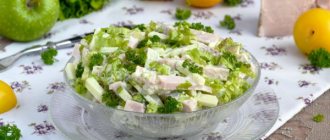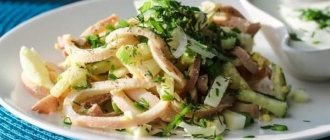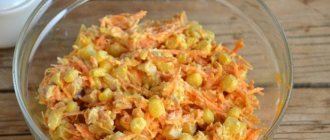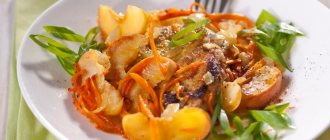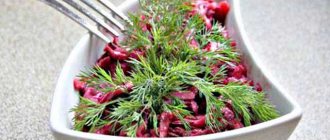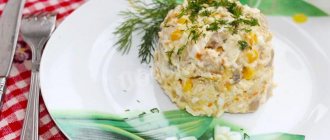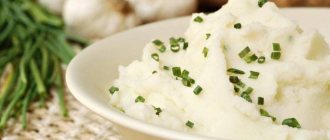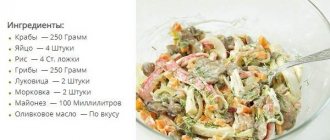Home Mixed salads
For many of us, Chinese salad is something unusual and extraordinary. Many housewives are of the opinion that you can try real Chinese food only in specialized stores, but this is not true!
There are several rules, following which it is quite possible to prepare a Chinese dish, or at least a very similar in taste to a Chinese dish. Firstly, in national Chinese cuisine, mayonnaise and sour cream are not used to prepare salads. Salads are usually seasoned with a mixture of various sauces. Secondly, salt is a very rare ingredient. In most cases, it is replaced with soy sauce. Thirdly, almost always vegetables and fruits used for preparing salads are either grated on a Korean carrot grater or cut into thin long strips.
Professional chefs who work in Chinese restaurants, above all else, recommend adhering to one very important rule. Only young cucumbers should be chosen for Chinese salads. In Chinese cuisine, it is not customary to peel and core a cucumber. This is why if the cucumber is old and overripe, it can completely ruin the taste of the salad.
How to cook Chinese salad - 15 varieties
- Chinese salad with meat
- Shandong salad
- Chinese homemade salad
- Spicy Chinese salad "Yang Ban Huang Gua"
- Salad "Harbin"
- Udon noodle and chicken salad
- Chinese salad with tongue
- Chinese apple salad
- Chinese salad "Chang-zhou"
- Chinese rice salad
- Chinese cucumber and tomato salad
- Eggplant salad in Chinese sweet and sour sauce
- Chinese seafood salad
- Salad “Broken cucumbers”
- Chinese salad "Xiang Xiang Tsai"
Preparing products for Chinese salads
If the salad contains products that require preliminary heat treatment, then it is carried out before preparing the salads. In 90% of cases, the meat is boiled, in the remaining 10% it is fried over high heat with the addition of sesame seeds and sauces. The noodles are boiled and washed well.
Vegetables need to be thoroughly washed and finely chopped. Most of them can be cut into strips or grated on a Korean carrot grater. Vegetables that require heat treatment are fried in a frying pan with the addition of spices and oils. May be served warm depending on the recipe.
Salad dressing acts as a marinade and is the main flavor catalyst. What the salad will be like - hot, spicy, sour, sweet - depends entirely on the combination of sauces chosen. In Chinese cuisine there are salads made from familiar ingredients - fresh cucumbers and tomatoes with herbs. But thanks to a special dressing, they acquire a bright, colorful taste.
Chinese salad with meat
Many people believe that Chinese dishes are something unearthly that our people will not always like. Chinese meat salad is the dish that shatters this stereotype.
Ingredients:
- Beef - 150 gr.
- Bell pepper - 1 pc.
- Cucumber - 5 pcs.
- Garlic - 6 cloves
- Sugar - 1 tsp.
- Onion - 1 pc.
- Greens - 1 bunch
- Red pepper, coriander, salt, soy sauce - to taste
Preparation:
Wash the cucumbers, cut them into large strips, place them in a deep bowl, salt them generously and mix thoroughly. Now let’s leave the cucumbers to infuse, but for now let’s move on to other products. Wash the meat, remove all veins, cut into strips and fry in a frying pan in olive oil.
You should not salt the meat while frying, otherwise the dish will not have the proper taste.
Wash the bell pepper, remove seeds and stalks and cut into thin strips. Peel the onion, wash it and cut it into thin half rings. Wash the greens, dry them and finely chop them. Grind the coriander in a mortar. Peel the garlic and pass it through a garlic press.
Drain the juice from the cucumbers and add pepper, onion, sugar, ground red pepper, coriander, garlic, herbs and meat to a bowl. You should also pour the juice that was formed as a result of frying the meat and soy sauce into the bowl. Now mix everything thoroughly and serve.
With peanuts
The characteristic flavor of nuts and vegetables makes the taste piquant and unexpected. Attention, it may become your favorite.
What you need to take for the base:
- beef meat - 0.15 kg.
- carrots - 1 pc.
- red onion - 1 pc.
- garlic - 4 pcs.
- fresh and unroasted peanuts - 0.2 kg.
- cucumber - 1 pc.
For the sauce:
- 1 tomato;
- 35 ml. fat from vegetable fibers and soy sauce;
- 4 gr. ginger and star anise in powder form;
- 2 gr. ground peppers, red and black;
- 5 ml. sesame seed oils.
Cooking principles:
- Take peanuts and cook them in boiling water. After 180 seconds, remove from heat and wait five minutes. Cool with cool water, transfer to paper towels and discard the skin. Set aside until completely dry.
- Prepare the vegetable component. To do this, we clean the onion and carrot from excess, chop the onion and garlic. Divide the cucumbers into straws. We remove the seeds from the tomatoes and cut the pulp into strips. We divide the cold beef with ice inside into canes. We pass clean carrots through a grater and press them into a deep bowl. Pour the remaining juice into a glass or sink.
- It's time for the butter. Heat it in a frying pan. Roast dry nuts until color changes. Add grated carrots to peanuts and mix. Add chopped garlic cloves and wait until they turn green and lightly brown. It's time to send out the beef. As soon as the golden crust appears, add the pepper. It smelled spicy!
- After the mixture has cooled, add the remaining vegetables into a bowl, season them with sauces and fragrant spices. We wait 30 minutes and serve. Bon appetit!
Shandong salad
“Shandong” is one of those Chinese dishes that will definitely appeal to many. This salad is very similar in its recipe to salads of Slavic cuisine.
Ingredients:
- Fresh cucumber - 300 gr.
- Boiled beef - 200 gr.
- Marinated mushrooms - 150 gr.
- Garlic - 2 cloves
- Soy sauce - to taste
Preparation:
Wash the cucumbers and cut them into cubes. After cooking, wash the beef and cut it into cubes. We wash the mushrooms and, if they are large, cut them into two or three parts. We peel the garlic, wash it and pass it through a garlic press.
In a deep container, combine cucumbers, beef, mushrooms and garlic. Add soy sauce there and mix everything thoroughly.
Chinese homemade salad
It cannot be said that the ingredients for a Chinese homemade salad are sold in any store or supermarket, however, a resourceful housewife will always find something to replace the missing products in order to achieve the desired taste in the final result.
Ingredients:
- Starchy noodles - 75 gr.
- White cabbage - 75 gr.
- Tree mushrooms - 1 pack
- Beef pulp - 200 gr.
- Cucumber - 1 pc.
- Soy sauce - 5 tbsp. l.
- Salt, pepper - to taste
Preparation:
Divide the noodles into parts, pour boiling water over them and leave to steep for 3 minutes, after which we drain them in a colander. Pour boiling water over the mushrooms. When they swell, pull them out of the water and cut them into strips. Wash the beef, cut into strips and fry in a frying pan until fully cooked. When the meat is ready, add mushrooms, salt and fry everything together for a few more minutes, stirring regularly. Wash the cabbage, chop it finely, mash it slightly, add steamed noodles to it and mix everything together. Wash the cucumbers, cut them into medium-sized strips, add them to the container with cabbage and noodles and mix again. At the very end, add the meat with mushrooms and soy sauce to the rest of the ingredients. Mix everything, salt and pepper to taste. Bon appetit!
Interesting facts about Chinese cuisine
- The main food of Chinese cuisine is called Fan. Typically, noodles and rice fall into this category.
- Additions to them in the form of fruits, vegetables, meat and seafood are usually called Tsai.
- The main vegetables of Chinese cuisine are cucumbers, eggplants, and beans.
- The main spices in Chinese cuisine are pepper, cloves, and fennel.
- A frying pan designed for preparing Chinese dishes – wok. It is used for frying noodles.
- All dishes are prepared only from fresh products, which are purchased immediately before the process of preparing a particular dish. According to Chinese traditions, it is not customary to leave food for the next day.
- Noodles can be cooked either as a dish on their own or as a basis for other recipes.
- In Chinese cuisine, recipes for dishes are quite simple, but this does not at all affect their sophistication, so many of them can be used as independent dishes or as an addition to others.
- Sauces in Chinese cuisine vary, but the most commonly used are sweet and sour. It is served with various dishes and serves as a dressing for meat. It is also added to salads, with which it goes quite harmoniously.
- Eggs are not used very often, but dishes containing them are usually delicacies.
- Dumplings are one of the national dishes, of which there are several types. The most popular of them are wontons. For Chinese cuisine, rice is the most basic dish. It can be eaten in its pure form, or it can be made the basis for a huge number of recipes. The most popular Chinese dishes are those made from meat, salads and soups.
- Why Chinese cuisine is spicy: because hot sauces, pepper and garlic are added to almost all dishes.
- Why Chinese cuisine is delicious: thanks to the variety of ingredients and their combinations in the right proportions, which have been compiled over a huge number of years.
A dish of Chinese cuisine
One of the most interesting and varied dishes that Chinese cuisine specializes in is soups. Their main difference is that beef is not used to prepare broths at all. These dishes are always prepared with pork, chicken or fish. According to the etiquette of Chinese culture, the liquid part of the soup is either drunk or scooped out with a spoon, but the situation is different with the solid pieces - they are eaten with chopsticks. The most popular are noodle soup and classic chicken-based broth.
Noodle soup recipe
There are many recipes for making noodles. This option is one of the simplest and most delicious. Cooking does not take much time, but this dish can be served for any holiday. Required ingredients:
- Chinese chicken broth – 600 ml;
- egg noodles – 300 g;
- green onions - 4 feathers;
- spinach – 100 g;
- crab sticks – 200 g;
- soy sauce - to taste;
- ham – 150 g.
Cooking at home does not take much time.
- Cut the meat into thin strips, and the crab sticks and onions into 2-3 cm pieces.
- Pour boiling water over the noodles. Leave it for 3 minutes and then rinse, after placing it on a sieve.
- The broth must be brought to a boil, then add noodles, chopped meat and crab sticks to it. After this, bring the soup back to a boil.
- Add the onion and spinach without removing the pan from the heat and cook for another minute.
- Remove the pan from the stove, add a little soy sauce to the soup. Ready!
Note: You can add some chopped boiled eggs if you wish.
Chinese Chicken Broth Recipe
This broth is easy to prepare. It can be used as a ready-made dish or as a base for any soup. List of ingredients:
- chicken fillet – 600 g
- ginger root – 4-5 cm;
- garlic – 2 pieces;
- chicken wings, necks, frames and legs – 2 kg;
- white part of green onion – 4 pcs;
- salt – 0.5 tsp.
You will need step-by-step preparation if you decide to repeat the Chinese masterpiece.
- Cut the chicken fillet into small pieces. Ginger root, without preliminary peeling, cut into slices 1 cm thick. Crush the garlic.
- Place chicken bones and fillets in a saucepan and fill them with 4 liters of cold water. Place low heat and wait until it boils. Reduce heat to low.
- Without stirring the broth, remove the foam from it for 20-30 minutes. Add onion, ginger, salt and crushed garlic. Continue to simmer the broth without covering it for another 4 hours. Next, you need to cool the dish and strain it.
Spicy Chinese salad "Yang Ban Huang Gua"
“Yang Ban Huang Gua” is quite a spicy dish, especially if you do not remove the seeds from the chili pepper. It is perfect as an addition to any meat dish.
Ingredients:
- Cucumber - 1 pc.
- Carrots - 1 pc.
- Chili pepper - 1 pc.
- Garlic - 3 cloves
- Salt - 1.5 tsp.
- Rice vinegar - 3.5 tbsp. l.
- Sugar - 1.5 tsp.
Preparation:
Peel the carrots, wash them and cut them into long thin strips.
To make the cooking process easier, you can simply grate the carrots using a Korean carrot grater.
Wash the cucumber and cut into wide strips. Wash the pepper and cut into thin strips. Peel the garlic, wash it and finely chop it.
When all the products are prepared, they should be combined in one container, salt, pepper, season with vinegar and mix thoroughly. It is best to place the finished salad in the refrigerator for several hours to let the vegetables release their juice, and then serve.
Salad "Harbin"
Harbin salad is one of the most popular dishes in Chinese restaurants in the Primorsky Territory. Now, armed with this recipe, everyone can prepare this restaurant dish themselves.
Ingredients:
- White cabbage - 450 gr.
- Funchoza - 100 gr.
- Carrots - 200 gr.
- Cucumber – 250 gr.
- Bell pepper - 100 gr.
- Egg - 1 pc.
- Garlic - 3 cloves
- Ground coriander, ground ginger, Korean funchose dressing, sesame seeds - to taste
- Sugar - 1 tsp.
Preparation:
Soak the funchoza in boiling water and leave to infuse. Wash the cabbage, dry it and finely chop it. Peel the carrots, wash them and grate them on a coarse grater into a bowl with cabbage. Now the carrots and cabbage should be mashed so that they begin to release juice. Wash the cucumbers and also grate them on a coarse grater. Wash the pepper, remove seeds and stems and cut into strips.
Break the egg into a small bowl, add 2 tbsp. l. water, beat and fry a pancake from it. Remove the finished pancake from the pan, cool and cut into small strips. We pull the funchose out of the water, cool it and, if necessary, cut it into several parts. Peel the garlic and finely chop it.
Place funchose, pepper, cucumbers, egg strips and garlic in a bowl with cabbage and carrots. Add coriander, sugar, sesame seeds, Korean funchose dressing and ginger. Mix everything thoroughly.
If the salad seems a little salty, you should not add salt to it. It is recommended to season it with additional soy sauce.
Step-by-step recipes with photos
When you walk into the produce section of an imported Asian supermarket, you'll likely be greeted by a dazzling but intimidating display of unusual Chinese greens.
They are all great and easy to make, but you do need some knowledge to properly combine them with other foods. That's why we've highlighted the most common varieties of greens you can find in Chinese grocery stores, along with their flavor profiles and how to eat them.
- Ah Choi
- Bok Choy
- Chinese broccoli
- Chinese celery
- Chrysanthemum greens
- Daikon Greens
- En Choi
- Fava Greens
- Cockaboo Greens
- Malabar spinach
- Mizuna
- Mustard greens
- Napa cabbage
- Snow pea leaves
- Tatsoi
- Water spinach
- Yu Choi
- 14 most popular types of leaves
- What is a truffle – 5 photos
- Brussels sprouts -…
- Green lettuce leaves -...
- The best marinade for steak...
- How to properly defrost fish
A Choy stems and leaves Latin name: Lactuca sativa. Also Known As: Taiwanese Lettuce, AA Chop Xin, Stem Lettuce, Asparagus Lettuce, Celery Lettuce, Keltuk, Wosun. Taste: The leaves are similar to romaine and the stems taste a little like cucumbers. There is also a slight bitterness. Texture: Leaves and inner stem like lettuce. How to cook: fry the leaves, stirring. The same goes for the stems or you can pickle them. If you are cooking the stems, remove the skin first. Available: all year round, but easiest to find in late spring, early summer.
Shanghai and baby bok choy Latin name: Brassica rapa ssp. chinensis Also known as: Chinese cabbage, pok choi, yóu cài, qīng cài (“blue-green vegetable” in Shanghainese). Taste: very mild, with its own unique mild peppery taste. Texture: The leaves are very tender and crisp, and the stems are firm and juicy, depending on the variety. The leaves are dark green or yellow-green. There are regular and mini varieties. Best cooking: frying, stewing, cooking soups. One of the most versatile and widely used lettuces in China, the leaves can be eaten raw in salad. Available: all year round, although the peak season is winter. Where to find: Available in most Asian markets, especially Chinese grocery stores.
Latin name: Brassica oleracaea, Alboglabra group. Also known as: Gai lan, kai lan, Chinese cabbage. Flavor: Similar to broccoli, but tarter and a little more bitter. Texture: Wide, flat, cabbage-like leaves and thick, tender stems. Best preparation: Blanched or steamed. Often served with oyster sauce, blanched or fried. Available: all year round. Where to find: Chinese shops.
Latin name: Apium graveolens var. secalinum. Also known as: Eastern celery. Flavor: Aromatic and herbal, but stronger than regular celery. Texture: The stalks are thin, hollow and crisp, but smaller and more tender than regular celery. The feathery leaves are used at least as often as the stems. Cooking: Often added to stir-fries and soups, but usually for its flavor rather than its texture.
Latin name: Chrysanthemum coronarium Also known as: garland chrysanthemum, edible chrysanthemum, chop suey greens, daisy greens, Japanese greens, tonghao, shungiku, sukgat, ải cúc, tần ô. Taste: Subtle mix of spicy, bitter, herbal and cooling. Suitable for everyone who loves chrysanthemum tea. Texture: Soft and feathery, with flat, toothed leaves and slightly crunchy stems. How to best prepare: Young greens can be eaten raw, but most sold in the market will be too ripe and bitter and should be lightly steamed or blanched. In Japanese cuisine, they are often added to soups or cooked in tempura style. Available: from spring to autumn. Where to find: Most Asian markets: China, Japan, Korea and Southeast Asia.
Latin name: Raphanus sativus var. longipinnatus. Also known as: muli, oriental radish, Japanese radish, Chinese radish, Korean radish, lo bok, bai luobo. Taste: The leaves are mild, but somewhat pungent and a little spicy, given the mustard oil that the plant naturally produces. The taste of radishes is different: the upper part is sweet, and the lower part is more spicy. Texture: The leaves are tender but crunchy. Best Cooking: In Western cooking, daikon greens are often used simply as a garnish, but in Asian cuisine they are often stir-fried, added to salads for added flavor, or even made into kimchi. Radishes can be pickled, served raw in salads or sweet dishes, simmered in soups, or stewed with meat. Available: all year round, most often in winter. Where to find: Asian farmers' markets, some supermarkets. Often sold without the greens, but some grocers stock them separately and sell them upon request.
Latin name: Amaranthus tricolor. Also known as: Bayam, Chinese spinach, Amaranth, phak khom suan, rau den, red honchoy. Taste: Similar to spinach. En choy refers to beets and their color comes from antioxidants called betalains. Texture: Fresh leaves and crisp stems. How to best prepare: Lightly steam, fry, or use raw in salad. Available: from spring to autumn. Where to find: Asian supermarkets, Chinese markets.
Latin name: Vicia faba. Also known as: pole bean, field bean, teak. Flavor: Sweet, buttery and earthy, bean-like. Texture: delicate, smooth, oily. Best when cooked: In Asian cooking, fava greens are commonly used to wrap seafood before cooking, but they also make an excellent addition to salads and pastas. Also used raw or fried. Available: from late spring to summer. Where to find: Farmers' markets and well-stocked Chinese shops.
Latin name: Brassica rapa ssp. brine. Also known as: Japanese white turnip, white salad turnip. Taste: The leaves are bitter, like mustard, but noticeably softer. The top is delicately sweet. Texture: Leaves are fluffy, soft and tender. Turnips have thin skin and are typically small and tender. How to cook: Once blanched, the leaves work well in cold vegetable dishes or as a garnish for soup. Turnips can be put in salads and soups, stewed or pickled. Given their small size, they are often served whole. Availability: in markets from early autumn to early summer. Where to find: Japanese supermarkets.
Latin name: Basella alba. Also known as: grape spinach, buffalo spinach, creeping spinach, azure spinach, Ceylon spinach, red-tipped spinach, poi choy, chankai. Taste: Reminiscent of peppers and citrus fruits when raw, or spinach when cooked. Texture: Juicy and crispy, with thick, meaty leaves when raw, or soft like spinach when cooked. Best way to prepare them: Eat them raw in salads, fry them, or add them to soups and curries. Where to find: Mostly Indian stores, but also found in some East Asian markets.
Latin name: Brassica rapa ssp. nipponsinica var. lacinata. Also Known As: Shui Tsai, Water Greens, Japanese Mustard, Kyona, California Pepper, Spider Mustard. Flavor: Bitter, sharp and savory, but milder than comparable greens such as arugula, mustard greens or frisée. Texture: Leaves are feathery with crisp, juicy stems. Preparation: can be used raw in salads, as well as fried and pickled. Available: all year round, best from autumn to late spring. Where to find: Japanese shops
Latin name: Brassica juncea. Also known as: gai choy, Chinese mustard, Indian mustard, leaf mustard. Flavor: Mustard greens have a distinctly tangy flavor, while red mustard tastes reminiscent of wasabi. The pungent flavor (and characteristic color of red mustard) is lost when cooked. Texture: The crisp leaves have a loose, tousled texture and are moderately mild in flavor. Best preparation: Steamed, sautéed or sautéed. Blanching before cooking softens the strong mustard flavor. Goes well in salads. Where to find: It's easy to find in most Asian markets, especially Chinese grocery stores and some specialty supermarkets.
Latin name: Brassica rapa ssp. pekinensis. Also known as: Chinese cabbage, Chinese cabbage, wombok (especially in Australia), baechu, wonbok, hakusai. There is a longer, narrower variety known as Michihili. Taste: Delicate, mild and slightly sweeter than regular green cabbage. Texture: Watery, dense and crisp, with thick stems. The leaves are thinner than green cabbage, but thicker than savoy cabbage, and are tender and juicy when cooked slowly. Best preparation: Frying, boiling in soup, marinated and crushed as a filling for Chinese dumplings. Also good raw, especially in salads and sweets. Availability: all year round. Where to find it: You can buy it in most supermarkets and Asian grocery stores.
Latin name: Pisum sativum var. saccharatum. Also known as: pea shoots, pea shoots. Taste: Refreshing, but more herbaceous, fresh. It tastes good enough that it can be prepared without aromatic additives. Texture: The stems are crisp and hollow and the leaves are tender. Best preparation: Frying, steaming or adding to soups. Availability: all year round, best from early spring to early summer. Where to find: Chinese products.
Latin name: Brassica narinosa. Also known as: spinach mustard, bok choy rosette, Japanese spinach. Taste: slightly bitter, like mustard, but softer. Texture: Thick, dark green leaves with crisp, juicy stems somewhat reminiscent of bok choy. Best preparation: adding to soups, frying in oil. Young tatsoi is well suited for salads raw. Availability: all year round. Where to find: farmers markets and Asian shops.
Latin name: Ipomoea aquatica. Also known as: Kangkong, ong choy, river spinach, water morning glory, water bindweed. Taste: very soft, slightly herbaceous, with nutty undertones. Texture: crispy, holds up very well even when cooked. Preparation: best steamed and seasoned with oyster sauce. You can also fry it, make soup, or eat it raw in a salad. Available: Mostly in summer. Where to find: stores in Southeast Asia or China.
Latin name: Brassica rapa var. parachinensis. Also known as: Chinese butter, you cai, yao choy, younger varieties are often called choisum. Taste: Slightly bitter, earthier than mustard greens. The leaves and small yellow flowers are also edible. It complements aggressive aromas well when frying. Texture: Thin, crispy, tender stems. Best preparation: Can be used in many recipes in place of bok choy. Thick stems should be peeled and trimmed. Available: all year round, grows from spring to autumn. Where to find: Chinese market.
other recipes
Udon noodle and chicken salad
Salad of Udon noodles and chicken is a very tasty and satisfying dish that can easily become the main dish on any table.
Ingredients:
- Udon noodles – 200 gr.
- Vegetable oil - 2 tbsp. l.
- Chicken fillet - 300 gr.
- Onion - 1 pc.
- Garlic - 3 cloves
- Ginger root - 2 cm.
- Mushrooms - 100 gr.
- Carrots - 50 gr.
- Soy sauce - 2 tbsp. l.
- Oyster sauce - 2 tbsp. l.
- Teriyaki sauce - 2 tbsp. l.
- Sesame - 2 tbsp. l.
- Green onion - 50 gr.
Preparation:
Boil the Udon noodles until fully cooked, rinse and let them cool. Wash the chicken fillet and cut into medium-sized cubes. Peel the onion, wash it and cut it into thin half rings. Chop the peeled garlic and ginger. Peel the carrots and cut into thin ribbons. We clean the mushrooms, wash them and cut them into strips.
Pour vegetable oil into a frying pan, heat it well, and then fry the chicken pieces in the frying pan. When the meat is almost ready, add onions, garlic, ginger, mushrooms and carrots to the pan. Now fry everything together for a few minutes and put it in a salad bowl.
In a small bowl, mix soy sauce, oyster sauce, sesame seeds and teriyaki sauce. Pour the resulting mixture into a salad bowl and mix everything thoroughly. Add noodles to the same salad bowl and mix again. Bon appetit!
Chinese salad with tongue
This salad can safely be considered dietary, because it contains only low-calorie foods, namely: tongue and vegetables.
Ingredients:
- Beef tongue - 300 gr.
- Cucumbers - 250 gr.
- Bell pepper - 1 pc.
- Red onion - 1 pc.
- Soy sauce - 2 tbsp. l.
- Sesame oil, sesame seeds, chili pepper - to taste
- Balsamic vinegar - 1 tbsp. l.
- Garlic - 2 cloves
- Cilantro - ½ bunch
- Coriander - ½ bunch
Preparation:
Wash the tongue, boil it, cool it, clean it and cut it into strips.
To make it easier to clean, immediately after boiling the tongue should be immersed in cold water for a few minutes.
We peel the garlic, wash it and pass it through a garlic press. Wash the cucumbers and cut into large strips. Peel the onion, wash it and cut it into thin half rings. Wash the pepper, remove seeds and stalks and cut into thin strips. Wash the greens, dry them and finely chop them
In one container, combine tongue, cucumbers, peppers, onions, garlic, herbs, soy sauce, vinegar, sesame oil and chopped chili peppers. Mix everything thoroughly. Before serving, sprinkle the salad with sesame seeds.
Salads: how are they prepared in Asia?
Salads are loved all over the world. The Chinese have their own secrets of preparing them. All dishes are distinguished by richness of taste, piquancy, and an abundance of seasonings and spices.
| Ingredients | Quantity |
| Garlic - | 3 cloves |
| Ground red pepper - | 20 g |
| Starchy noodles - | 200 g |
| White cabbage - | 50 g |
| Bulgarian pepper - | 200 g |
| Soy sauce - | 30 g |
| Radish - | 100 g |
| Ground black pepper - | 20 g |
| Carrot - | 30 g |
| Jusay - | 20 g |
| Chicken breast - | 200 g |
| Bulb onions - | 30 g |
| Salt - | taste |
| Cooking time: 50 minutes | Calorie content per 100 grams: 75 Kcal |
Scald the noodles with boiling water and drain in a colander;
Finely chop the onion, radish, cabbage, carrots and pepper. You can use any other vegetables that are in season. Fry them in oil such as olive or soy;
Cut the meat into thin strips and fry. Add spices and simmer over low heat with a lid;
Place noodles, vegetables and meat in a salad bowl. Stir;
The dish can be served cold or warm.
Broccoli salad in oyster sauce
- Broccoli - 400 gr.;
- Chicken broth - 1/2 cup;
- Vegetable oil - 7 tbsp. l.;
- Ginger - 50 gr.;
- Cane sugar - 20 gr.;
- Salt - a pinch;
- Oyster sauce - 4 tbsp. l.
- Separate broccoli into florets. Cut each in half;
- Heat the oil in a frying pan, add salt and finely chopped ginger;
- Place broccoli in a frying pan and fry for 3 minutes;
- Add sugar, broth and sauce. Stir the dish and leave to simmer for a few minutes;
- Serve the salad hot with meat, fish or potatoes.
Chinese apple salad
Chinese apple salad is an incredibly healthy dish that can be eaten by everyone. The main reason for this state of affairs lies in the fact that the salad consists exclusively of fresh vegetables and fruits.
Ingredients:
- Carrots - 1 pc.
- Cucumber - 1 pc.
- Apple - 1 pc.
- Soy sauce - 1 tsp.
- Vegetable oil - 1 tbsp. l.
- Honey - 1 tbsp. l.
- Sesame seeds - 1 tbsp. l.
Preparation:
We clean and wash the carrots. Wash the cucumber and apple. Now the apple, cucumber and carrots should be grated on a coarse grater into one container. In a small bowl, combine honey, soy sauce and vegetable oil. Mix everything thoroughly. The sauce is ready! Pour the sauce over the prepared products, mix and sprinkle with sesame seeds.
Chinese salad "Chang-zhou"
This Chinese dish got its name after the city in which it was first prepared. It was a small town in one of the Chinese provinces called “Chang-zhou”.
Ingredients:
- Dried wood mushrooms - 150 gr.
- Onions - 4 pcs.
- Vinegar - 1 tbsp. l.
- Carrots - 3 pcs.
- Garlic - 4 cloves
- Allspice peas - 5 pcs.
- Coriander grains - 3 pcs.
- Vegetable oil - 100 gr.
- Soy sauce - 4 tbsp. l.
- Salt, pepper - to taste
Preparation:
Place the mushrooms in a pan, fill them with cold water, add salt to the pan and put it on the fire. When the mushrooms come to a boil, reduce the heat and simmer, covered, over low heat for about 1 hour. After this time, remove the mushrooms from the heat, place in a colander, cool and cut into small strips.
We clean the onion, wash it, cut it into thin half rings, add vinegar, stir and let it stand for a few minutes. We clean the carrots, wash them, grate them on a Korean carrot grater, sprinkle with salt and mash well so that they release juice. Place the carrots and onions in a container with mushrooms and mix. Peel the garlic and pass it through a garlic press. Grind allspice and coriander in a mortar. Now add the garlic and spices to the salad. Pour vegetable oil into a frying pan and set it to heat. When it reaches a high temperature, it must be carefully poured into the salad. Pour in soy sauce and add pepper. Mix everything thoroughly. After 2 hours, the salad can be served.
Chinese food recipes
There is hardly at least one person in the world who has never heard of Chinese cuisine.
In fact, according to statistics, Chinese food is one of the most loved foods in the entire world. Proof of this is that almost every city has Asian restaurants or cafes. Read more about Chinese cuisine Ramen noodles are amazingly versatile: you can use them in soups, desserts, and even pizza. Here are some of our favorites
Chinese chicken salad
- 100
The hero of this Chinese salad is baked chicken breast, smeared with soy sauce and dark sesame oil. It is cut into slices and mixed with the rest of the salad ingredients: thinly.
Vegetarian wontons in a steamer
- 100
This dish can compete with any pasta with filling and sauce. The base filling of these vegetarian Chinese dumplings is tofu, which is mixed with grated carrots, shredded.
Vegetable stir-fry
- 100
Introduce more vegetables into your daily diet, and with this recipe, you will truly enjoy them. Vegetables are cooked using the Asian stir-fry technique, over high heat and constant.
Crab rangoons
- 100
Crab rangoon is a popular appetizer made in the form of deep-fried crab-filled wontons. Despite its Asian style, the snack was invented in the USA and is very popular in local Chinese.
Wonton soup
- 100
This Chinese soup is filled with fluffy wontons filled with succulent spicy pork filling, bok choy, bamboo shoots and shiitake mushrooms. All components are added to the rich spicy flavors.
Teriyaki salmon and quinoa bowl
- 100
The base of the bowl is boiled tri-color quinoa mixed with a small amount of soy sauce. The cereal is placed in deep bowls and topped with pieces of fried salmon in teriyaki sauce and.
Chicken in sweet and sour sauce "Gongbao"
- 100
This Chinese dish uses juicy, boneless, skinless chicken thighs. Cut them into cubes and fry with hot chili peppers, and then mix with separately fried vegetables -.
Meat dumplings for a Chinese holiday table
- 100
Guotie are fried Chinese dumplings filled with meat that can be served as an appetizer with dipping sauce at a house party. In this recipe, the gootie is assembled using prepared wonton dough, which.
Fried rice with tofu, ginger and shiitake mushrooms
- 100
Join the international Meatless Monday movement to contribute to the environment and make your diet healthier. And so that you don’t miss meat dishes on this day.
Chinese guotiye dumplings with chicken and dipping sauce
- 100
Guotie are Chinese jiaozi dumplings filled with meat, which after cooking are quickly fried in a frying pan until golden brown and served as an appetizer or main dish with a dipping sauce.
Mapo tofu
- 100
Mapo tofu is one of the most popular dishes in Sichuan cuisine. It's infused with the aroma of the region's signature spice, Szechuan pepper, as well as the rich, spicy flavor of dobajiang bean paste. According to.
Glazed Chinese green beans
- 100
Before pan-frying, long beans are blanched in boiling water for a couple of minutes to soften the pods a little while maintaining their crispness. Fry the beans in butter with.
Danhuatang: Chinese egg soup
- 100
Danhuatang is a traditional Chinese soup whose main ingredients are broth and egg. The beaten egg is poured into the hot chicken broth in a thin stream and turns into thin flakes. More.
Chop suey: Chinese stew
- 100
Chop suey is a popular Asian stew in the United States, invented by Chinese immigrants. It contains pieces of chicken (or turkey), various vegetables - Chinese cabbage, celery, bamboo shoots, etc.
Bok choy stir-fry with ginger and garlic
- 100
The best and fastest way to cook bok choy is to fry it in an Asian stir-fry technique with spices. The cabbage is fried, stirring frequently, until it becomes slightly softer. At.
Chinese pork soup
- 100
This hot and sour soup is thick, rich and very tasty, just like in an Asian restaurant. It contains muer wood mushrooms, ginger, pork, bamboo shoots, soy sauce, tofu, egg, and rice.
Baozi - steamed pork buns
- 100
Chinese baozi buns are prepared from yeast dough with fillings in a steamer and turn out very tender and airy, and juicy inside. Buns according to this recipe are filled with pork, removed from...
Fried rice
- 80
Fried rice is a delicious Asian-inspired dish that can be made using leftovers from last night's dinner and enjoying new, bold flavors. It contains boiled rice, cooked meat (anything...
Soba noodles with smoked trout in broth
- 100
Asian-style noodle soup is prepared quite simply and quickly, but the taste is very rich and rich. Separately boiled buckwheat soba noodles and spinach are placed in bowls and poured.
1.
Chinese cuisine is very diverse. It is different in every Chinese province. For example, in the north of the country the main product is noodles, and in the south it is rice.
2.
However, noodles and rice are the most common products in China. They are eaten throughout the country.
3.
In ancient times, neither knives nor forks were used during meals in China, since they were previously used as weapons. Thus, most Chinese dishes are prepared in bite-size pieces that can be taken and immediately popped into the mouth without having to bite.
Chinese rice salad
Rice is one of the most common products in China. It is quite natural that it is often used to prepare all kinds of dishes and salads, in this case, are no exception.
Ingredients:
- Round grain rice - 300 gr.
- Smoked ham - 100 gr.
- Sweet pepper - ½ pc.
- Frozen green peas—100 gr.
- Eggs - 3 pcs.
- Vegetable oil - 5 tbsp. l.
- Chinese spices - 1 tsp.
- Salt - to taste
Preparation:
Boil the rice, rinse, cool, rinse again and place in a frying pan with vegetable oil. Separate the meat from the smoked ham from the bone and cut the meat into medium-sized pieces. Then it should be added to the pan with the rice. Mix the rice and meat and fry in a heated frying pan for about 5 minutes. Wash the pepper, remove the seeds and stems and cut into small cubes, which immediately after cutting we place in the frying pan. Fry the rice, meat and pepper together for 5 minutes.
In another frying pan fry the eggs. They should be fried for several minutes, stirring constantly. You should end up with some sort of little egg pieces. Then add the egg pieces to the pan with rice, meat and pepper and mix everything thoroughly.
Place the peas in a colander, pour cold water over them, let the water drain and place them in a frying pan with other products. Along with the peas, add salt and Chinese spices to the pan. Mix everything and fry for 5 - 7 minutes. The salad is ready. It should be served as a separate dish while still warm.
Chinese salad with crab sticks
Chinese salad or Chinese cabbage is a vegetable rich in vitamins. It's delicious in any salad, but when combined with crab sticks it takes on a nice twist. Crab salad with bok choy is tender and light. We suggest using mayonnaise in the recipe, but you can season it with sour cream or Greek yogurt and add a little lemon or lime juice. The salad is ready in a matter of minutes.
Ingredients:
- Chinese cabbage – 1/2 pcs.;
- crab sticks – 240 g;
- boiled eggs – 3 pcs.;
- fresh cucumbers – 1-2 pcs.;
- dill, parsley (optional);
- red onion (Crimean) – 1 pc.;
- canned corn – 1 can;
- mayonnaise – 200 g;
- salt, ground pepper to taste.
How to make crab salad with Chinese cabbage:
- Boil the eggs (5 minutes).
- Finely chop the cabbage and crush it with your hands to soften it.
- Cut the cucumbers and crab sticks into cubes.
- Cut the onion into half rings.
- Chop the greens.
- Mix all ingredients, add corn, salt, pepper and season with mayonnaise or yogurt.
Read how to cook Chinese udon noodles on the pages of Joy-pup .
Chinese cucumber and tomato salad
This salad is very similar to the vegetable salad we all know from tomatoes and cucumbers. What makes Chinese salad different is the seasonings used.
Ingredients:
- Cucumber - 1 pc.
- Tomato - 3 pcs.
- Cilantro - 1 bunch
- Garlic - 2 cloves.
- Hot pepper - 1 pc.
- Rice vinegar - 1 tbsp. l.
- Salt, sugar, sesame oil - to taste
Preparation:
Wash the cucumber and cut into thin slices. About 3 mm thick. Wash the tomatoes, remove the stem attachment point and cut into small cubes. Wash the cilantro, dry it and cut it into medium-sized pieces. Peel the garlic, wash it and cut it into small cubes. Wash the pepper, remove seeds and stalks and cut into strips. Combine the prepared vegetables and herbs in one container and add vinegar, salt, sugar, and sesame oil. Mix everything thoroughly.
Eggplant salad in Chinese sweet and sour sauce
There are many classifications of lettuce. This dish falls into two categories at once. It can be classified as both hot and cold salads.
Ingredients:
- Eggplants - 2 pcs.
- Bell pepper - 2 pcs.
- Starch - 2 tbsp. l.
- Vegetable oil - for frying
- Garlic - 2 cloves
- Salt - to taste
- Water - 1 glass
- Fresh ginger - 15 gr.
- Soy sauce - 35 gr.
- Rice vinegar - to taste
- Honey - 20 gr.
Preparation:
Wash the eggplants and cut them into medium-sized cubes.
To rid them of excess salt, it is recommended to cover them with salt, mix and leave to infuse for at least 15 minutes.
After this time, drain the excess liquid from the eggplants, squeeze them out, dry them, add 1 tablespoon of starch and mix. Then fry the eggplants in a frying pan in vegetable oil.
Wash the bell pepper, remove the seeds and stems, cut into strips and fry in a frying pan in vegetable oil until golden brown. Then the pepper goes into the pan with the prepared eggplants. Mix everything, season with dressing and fry everything together for about 5 minutes. To prepare the dressing, combine soy sauce, rice vinegar, honey, water, starch and chopped ginger in a small bowl. Mix everything thoroughly.
At the very end of cooking, add chopped garlic to the pan. Salad ready!
Chinese seafood salad
According to the original recipe, black caviar should be used in this salad, however, this product is not available to everyone. For this reason, Chinese seafood salad can be prepared with protein caviar, or pike caviar.
Ingredients:
- Funchoza - 1 pack
- Boiled mussels - 150 gr.
- Dressing for funchose - 1 package.
- Protein caviar, Teriyaki sauce - to taste
Preparation:
Pour boiling water over the funchose and leave to steep for a few minutes. After the time has passed, throw the funchose into a colander, rinse and let all excess liquid drain. Next, it should be cut so that it is not too long and placed in a deep salad bowl. In the same salad bowl add mussels, funchose dressing, protein caviar and Teriyaki sauce. Mix everything thoroughly and serve.
Salad “Broken cucumbers”
“Broken cucumbers” are one of the most popular dishes in Chinese cuisine. Its main ingredients are cucumbers. Everything else is a variety of sauces, herbs and seasonings.
Ingredients:
- Cucumber - 500 gr.
- Garlic - 2 cloves
- Parsley - 2 sprigs
- Soy sauce - 20 gr.
- Rice vinegar - 30 gr.
- Sesame oil - 15 gr.
- Chili pepper, salt - to taste
Preparation:
Wash the cucumbers, cut them lengthwise into two parts, and remove the core from the resulting halves using a spoon. Now cut the cucumber halves into strips, place them in a deep salad bowl, pour over soy sauce, vinegar, salt, mix and leave to marinate for 15 minutes.
While the cucumbers are pickling, peel, wash and chop the garlic. Wash and finely chop the chili pepper. Squeeze the pickled cucumbers from the marinade and place in another deep plate. Add pepper or garlic and chopped parsley to the same plate. Fill everything with sesame oil and, if desired, add soy sauce. Mix the salad and serve.
coral mushroom
Despite the name, the coral mushroom has nothing in common with the sea; it chooses a cozy place on the stumps and trunks of fallen trees. The coral mushroom is simply a miracle, it has a beautiful exotic appearance, reminiscent of a branch of sea coral, it is a real pearl of nature - translucent snow-white lace. In addition, mushrooms are very healthy and nutritious: they contain about 70% dietary fiber, proteins, carbohydrates, minerals, as many as 18 valuable amino acids, they are a real storehouse of plant glycogens (special polysaccharides), necessary for immunodeficiency, serious stress, to slow down the aging process and memory improvements. Coral mushroom has many names: sea mushroom, snow, gelatinous, ice mushroom, royal, tremors, silver ear. Scientific name: tremella fuciformis . The coral mushroom, which has come into fashion recently, quickly acquired its own army of loyal fans.
The flesh of the mushroom is fleshy, at the same time tender and crispy, elastic-gelatinous, springy, usually odorless (rarely has a pleasant faint odor).
Before use, coral mushroom needs additional preparation. Pour the required amount of coral mushrooms with water at room temperature for a period of 30 minutes to several hours (depending on the dish in which they will be used), the mushroom will absorb the water and fully open. It should be taken into account that when the mushroom swells, it increases in size by 8-10 times. Then rinse the mushroom and divide it into small inflorescences with your hands, maintaining a beautiful wavy shape. If there is, cut off the hard parts at the base.
The simplest recipe is to marinate coral mushrooms. Wonderfully delicious, you just can’t stop eating! They are unique, unlike anything else, slightly crispy, very thin, with a sharp and sour taste. The spiciness inexplicably arises even without the addition of pepper - from a simple marinade of vinegar, sugar and salt. The pickled translucent white mushroom can be eaten on its own as a savory snack. But you can serve it with potatoes (boiled, stewed, fried, mashed), with sweetish beef stewed in tomato sauce and with other dishes that require a light hot and sour appetizer, for example, instead of pickled peppers.
